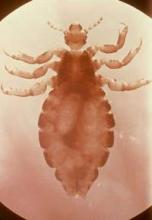As summer has come to a close and children are settling into their new classrooms and routines, there is one thing certain about back to school season – pediculosis capitis, more affectionately known as lice. My own children hadn’t been back in school 3 days when they came home with the dreaded note in their backpacks alerting parents that there had been cases of head lice identified in the school. While there are some variations in susceptibility (males and black children tend to be affected less frequently than are females and children of other races), head lice infestations are incredibly common in children, and are one of the most frequently seen communicable diseases in elementary school settings.
Many parents will appropriately treat their children with home remedies and/or over-the-counter medications, so most of these children aren’t seen in our offices. However, families frequently have questions about the best or most effective methods of treatment, or need help with cases that are difficult to resolve. So, what is the best method of treatment? As with many conditions, the answer is that it depends on parent preference and the resistance patterns in the community.
The first step in the process is twofold – make sure that treatment is needed, and reassure the parent if it is. The best way to diagnose head lice is visualization of a live, active louse. This is best done using a small, fine-toothed comb to systematically examine all areas of the scalp and hair at least twice over. Visual inspection without systematically combing through the hair misses a large number of cases. Relatedly, the presence of nits (or eggs – small whitish, oval capsules that firmly adhere to the base of the hair shaft) does not definitively indicate infection. A sizable percentage of children with nits do not go on to develop active lice infections, and nits may be present several months after effective treatment. That said, a high concentration of nits over a relatively small area (1/4 inch) makes the incidence of active infection more likely. Lastly, the presence of itching alone does not indicate active infection (as evidenced by the large number of you who are likely itching your heads just reading this article). If treatment is in fact needed, parents should be reassured that this is a very common condition, unrelated to cleanliness of the home or school, and something that almost everyone faces at sometime during their school years.
The most common first line treatments are the topical pediculicides, including the pyrethroids (available over the counter), malathion, benzyl alcohol, spinosad, and topical ivermectin. These medications are generally safe and well tolerated (alternately, lindane is only recommended as a second line treatment, and not recommended in children, because of its possible toxic side effects). The Centers for Disease Control and Prevention website has a nice summary of the available medications, their indications, and common side effects to help guide your decision making. The pyrethroids are generally well tolerated and are available over the counter and thus, despite increasing resistance, are commonly used first line medications. Malathion is also frequently used and recommended, especially as it likely has greater efficacy than the pyrethroids, but the fact that it requires a prescription and has a very strong odor can make it a less tolerable choice for families. Oral medications are available for use as a second line therapy or in recalcitrant cases.
For families who prefer not to use topical pediculocides, or for very young children, wet combing is a possible alternative. This technique involves wetting the air with a lubricant such as hair conditioner or olive oil and systematically combing the hair with a fine tooth comb until no lice are found. This should be repeated every 2-4 days and continue for 2 weeks after the last live louse is found. This technique also can be a useful adjunct to topical pediculocide treatment. The downside to this technique, as anyone who has ever done it can attest to, is that it is time consuming and difficult to get small children to sit still through it. Using topical agents such as petroleum jelly or Cetaphil cleanser to attempt to suffocate the lice is a common, but not well studied or validated approach. It is certainly harmless and possibly effective, but parents should be aware that there is not strong evidence to support this technique.
Additionally, at the time of diagnosis and treatment for all families, any bedding or towels the infected child has had contact with in the past 48-72 hours should be washed in very hot water and anything (such as stuffed animals or pillows) that can’t be washed should be put in an air-tight bag for 2 weeks. Vacuuming of carpets in the home also may be helpful. Close household contacts should be carefully monitored for infection, and any contacts who share a bed should be considered for prophylactic therapy. Children should be allowed to return to school as soon as they are treated. “No-nit” policies are not recommended or helpful, and if your school or school district has them it is an opportunity for education and advocacy to minimize the number of days children unnecessarily miss school.


